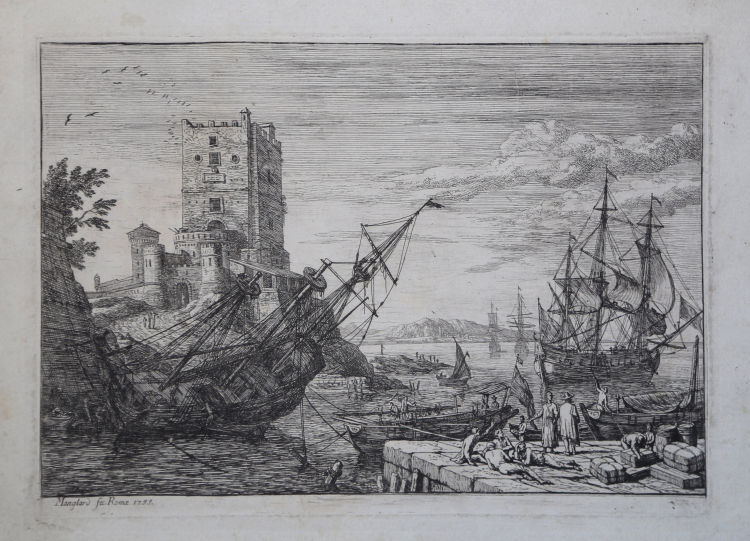



| Reference: | S657 |
| Author | Adriaen MANGLARD |
| Year: | 1753 |
| Zone: | Naples |
| Printed: | Rome |
| Measures: | 318 x 225 mm |


| Reference: | S657 |
| Author | Adriaen MANGLARD |
| Year: | 1753 |
| Zone: | Naples |
| Printed: | Rome |
| Measures: | 318 x 225 mm |
View of the port of Naples engraved by the famous french painter.
Taken from Diverse Compositioni e Vedute inventate ed intagliate da Adriano Manglard in Roma l'an. 1753.
The harbour with the square tower: a three-masted boat moored in a port in which another is careened on its side, with a fort with a square tower guarding the entrance.
Etching, lettered with “Manglard fec. Romae 1753” - First state, before the number, in very good conditions.
Adrien Manglard (10 March 1695 – 1 August 1760) was a French painter, draughtsman, and engraver. He was a skilled marine painter, who was able to rapidly advance his career in Rome thanks to his compositional skills, selling paintings to clients such as the Rospigliosi family, Victor Amadeus II, King of Sardinia, and Philip, the Duke of Parma. The latter alone commissioned more than 140 paintings from Manglard. The son of a modest painter, Manglard was trained in Lyon by his godson Adriaen van der Cabel, a Dutch Golden Age landscapist. In 1734 Manglard was admitted to the Académie Royale de Peinture et de Sculpture, which he entered as a full member in 1736. In his youth he traveled to Rome, where he spent most of his life. He is said to have trained under Bernardino Fergioni (1674–1738) in Italy. Manglard also came into contact with artists in the circle of sculptor Pierre Le Gros the Younger (1666–1719), who commissioned two paintings from him before 1719. Manglard's best known pupil is arguably Claude-Joseph Vernet, who, upon his arrival in Rome, was welcomed by Manglard into his studio and initiated into seascape painting by him and Fergioni. Once concentrated in Rome, his work is today spread across private and institutional collections around the world. Manglard is also known for his mural painting. He painted the frescoes of two rooms in the Palazzo Chigi in Rome, including the Sala delle Marine.
|
Robert-Dumesnil 1835-71 I.239.9.
|
Adriaen MANGLARD (Lyon, 1695; Roma, 1760)
|
French painter, draughtsman and engraver, active in Italy. The son of a modest painter and godson of Adriaen van der Cabel, he learnt figure painting with Frère Imbert in Lyon. He travelled to Rome in 1715, where he spent much of his time making studies of ships (Paris, Mus. A. Déc.) and even of Turks and camels (Paris, Ecole N. Sup. B.-A.). He also trained in the studio of Bernardino Fergioni (1674–1738) and learnt from those artists in the circle of the sculptor Pierre Legros, who was to purchase two seascapes by Manglard before 1719. His skill as a marine painter was such that his career advanced rapidly: prestigious clients included Victor Amadeus II, Duke of Savoy and King of Piedmont, who bought two matching pieces from him in 1726 (Turin, Gal. Sabauda), and Philip, Duke of Parma (d 1765), who acquired a pair in 1759 (Colorno, Pal. Ducale), and the Rospigliosi family in Rome, for whom he produced a number of pictures (Rome, Mus. N. Romano).
|
|
Robert-Dumesnil 1835-71 I.239.9.
|
Adriaen MANGLARD (Lyon, 1695; Roma, 1760)
|
French painter, draughtsman and engraver, active in Italy. The son of a modest painter and godson of Adriaen van der Cabel, he learnt figure painting with Frère Imbert in Lyon. He travelled to Rome in 1715, where he spent much of his time making studies of ships (Paris, Mus. A. Déc.) and even of Turks and camels (Paris, Ecole N. Sup. B.-A.). He also trained in the studio of Bernardino Fergioni (1674–1738) and learnt from those artists in the circle of the sculptor Pierre Legros, who was to purchase two seascapes by Manglard before 1719. His skill as a marine painter was such that his career advanced rapidly: prestigious clients included Victor Amadeus II, Duke of Savoy and King of Piedmont, who bought two matching pieces from him in 1726 (Turin, Gal. Sabauda), and Philip, Duke of Parma (d 1765), who acquired a pair in 1759 (Colorno, Pal. Ducale), and the Rospigliosi family in Rome, for whom he produced a number of pictures (Rome, Mus. N. Romano).
|